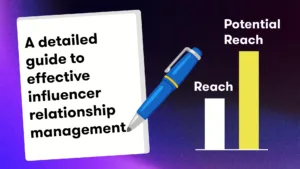The Ultimate Guide To Effective Influencer Relationship Management
After bouncing around tech start-ups and university literature programs, Joe has finally settled down as Billo’s Head of Content. Joe now spends his days writing ads about ads, teaching clients how to craft killer content, and combing through our web copy with a bold red Sharpie.

Influencer marketing is booming. The latest statistics show that the global influencer marketing market size has tripled in the last five years (source). Working with influencers provides incredible opportunities for marketers and business owners to reach new audiences and create and convert leads, but it’s critical to have a plan.
In this guide, we’ll discuss the importance of influencer relationship management, highlighting best practices and sharing tips to draw up an effective strategy.
The importance of influencer marketing
Influencer marketing has become increasingly influential. According to the State of Influencer Marketing Report 2024, almost 70% of marketers are planning to spend more on influencer marketing in 2024, and 63% claim that IGC (influencer-generated content) is the most impactful form of branded content (source).
There are currently more than 5 billion social media users in the world. Influencer marketing offers opportunities for brands to connect with customers, raise brand awareness, and boost sales through relationships with content creators.
Studies show a growing interest in influencers on social media. Around 40% of users now follow content creators online, but this figure jumps to 67% (male) and 77% (female) among users aged 18-29. Half of female users in this age group have purchased products due to influencer campaigns or posts (source).
What is influencer relationship management?
Influencer relationship management (IRM) is often likened to customer relationship management (CRM). The key difference lies in the focus. Rather than zoning in on customer relationships, the strategy centers on relationships with influencers. Teaming up with influencers doesn’t always guarantee results. One way to maximize the chances of success is to implement an influencer relationship management strategy. The primary aim is to build strong relationships with influencers to achieve brand objectives. The best collaborations and relationships are mutually beneficial. Influencers should become strategic partners, helping brands to promote products and services, establish trust and boost engagement.
What are the Benefits of Influencer Marketing?
There are multiple benefits of influencer marketing for marketers, sales teams and business owners. From start-ups to international brands, drawing up an effective, targeted influencer marketing strategy can help you achieve the following goals:
- Increase brand awareness: One of the most significant advantages of influencer marketing is increasing brand awareness. Influencers have a ready-made following, which enables brands to tap into new markets and reach more customers. By working with content creators, companies can expand their reach and get people talking about their brand and their products and services.
- Expand into new markets: Social media has the capacity to blur boundaries, creating opportunities for brands to expand into new markets and attract more customers. Apps like TikTok and Instagram are popular the world over. Social media influencers can bring customers in from across the globe.
- Boost your online following: Collaborating with influencers is a brilliant way to boost your social media profile and increase your follower count. Targeted posts trigger a ripple effect, meaning that followers who engage with influencers start to follow the brands they promote too.
- Encourage customer feedback: Building trust through authentic influencer relationships offers valuable opportunities to collect customer feedback and thoughts. When influencers engage with followers, they’re likely to be more open in sharing honest opinions and putting ideas forward.
- Establish a good reputation: Hiring the right influencers can help brands build trust and establish a good reputation. Users want to see authentic, credible content. Social media posts, videos and stories are an excellent way to connect and interact with followers and demonstrate how products work. Influencer-generated content (IGC) often works well alongside user-generated content (UGC) when showing how products work and rating them. This tactic is popular among beauty and cosmetics brands, for example.
- Improve sales: Influencer marketing can help you improve sales by attracting new customers and encouraging repeat orders. Methods like offering discount codes and savings on specific products can drive sales.
- Fresh ideas: Creating original, engaging content regularly is a challenge even for the most innovative and imaginative marketing teams. Influencer marketing can help you benefit from fresh ideas and perspectives.
- Increase ROI: Increasing ROI is a primary objective for most company owners and sales and marketing teams. Statistics show that the top 13% of brands earn a staggering $20 per $1 spend (source).
Why is Influencer Relationship Management Important?
Influencer marketing has the potential to drive sales, increase brand awareness, build strong, long-lasting relationships with customers and supercharge ROI, but it doesn’t always work. The key to successful relationships lies in finding the right influencers and establishing positive ties.
A good relationship should benefit the content creator and the brand. Strategic influencer relationship management helps brands capitalize on the popularity and impact of influencer marketing.
If influencers don’t have strong relationships with brands, they may not be complimentary about products and they might decide to cut ties and represent competitors.
Effective IRM offers the following benefits:
- A clear picture of how well relationships are going
- Tracking engagement and lead creation and conversion rates
- Encouraging long-term relationships with content creators
- Enhancing your brand image and reputation through positive relationships with influencers
Key Steps in Management for Influencers
There are three key steps involved in managing influencer relationships. These include:
- Finding the right influencers – the first step is to find the right influencers for your business or brand. Focus on your campaign objectives, your brand identity and your ideal customer. Search for influencers with an excellent reputation and an interest in your products and services. Look for creators who engage with their audiences and have an established following, which fits with your target audience. Take the time to identify the best influencers for your brand. Making the right decision is critical. Treat this process like a recruitment drive. Get to know influencers and prioritize values and goals as well as follower numbers, previous campaign results and engagement rates.
- Establishing positive relationships – once you’ve identified influencers you want to work with, the next stage involves building positive relationships. Strong relationships increase the chances of achieving success for both brands and content creators. Find out more about the person behind the TikTok or Instagram profiles, treat influencers with respect and keep channels of communication open. Be clear about your expectations and objectives.
- Tracking performance levels – the next step is to track performance levels based on key metrics. Outline metrics based on your campaign objectives. Collect and analyze data continuously.
Tips to Find the Right Influencers
Joining forces with the right influencer is essential. While a solid relationship with the perfect influencer can drive brands forward, the wrong choices can impact everything from sales and engagement rates to brand image and reputation. To help you find the right influencers, here are some tips:
- Research influencers before you decide who to work with: Carry out extensive research to identify potential candidates. Use analytics and assess metrics that align with your campaign or overarching business objectives. Go beyond follower numbers. Look into engagement rates, follower sentiment and the number of comments, likes and shares. Evaluating social media metrics is important for brands, but it’s also wise to get to know influencers on a deeper level. The aim is to find creators who will appeal to your customers or followers. Look for individuals who have shared values and goals. View previous campaigns and find out more about their reputation. When you decide to share collaborative posts, influencers will represent your brand. You want public sentiment to be positive.
- Always focus on your target audience: Concentrate on your target customers when researching and recruiting influencers for your brand. The influencer you choose should be a natural fit. You want prospective customers and followers to relate to them, trust them and enjoy watching or reading their content. Influencers should have a following that is relevant to your brand. If you own a clothing or beauty brand, for example, it’s pointless teaming up with an influencer who specializes in talking about financial products.
- Connect with influencers who love your brand: Social listening can help you identify influencers who already have an interest in your brand. Connect with people who like your posts or follow your social media accounts and have a chat about collaborating. If you’re a new business, or you don’t currently have any followers with a substantial following, look for influencers who follow brands in the same industry.
Strategies for Building Strong Relationships
The main objective of an influencer relations manager is to build strong, long-lasting relationships between brands and influencers. Here are some essential elements to prioritize:
Authenticity and alignment
Over 60% of marketers consider authenticity the most crucial aspect of influencer-generated content (source). Influencer relationship managers should seek out influencers who have authentic connections with their followers and a natural alignment with the product or brand.
Make sure the influencer fits with your brand identity, messaging and core values. Consumers are less likely to buy if they feel that content isn’t genuine or relevant to them. Always consider your target audience when selecting influencers.
Clear communications and expectations
Communication is fundamental to successful, impactful influencer relationship management. Influencers should be able to communicate openly and honestly with brand representatives and vice-versa.
It’s important for relationship managers to listen to influencers and encourage them to share opinions, ideas and expertise. Equally, influencers should listen to relationship managers and understand the importance of sticking to the brief and respecting the brand’s vision and objectives. Conversation should be a two-way street. If it’s one-sided, the relationship may not last.
As well as communicating clearly, both influencer relationship managers and influencers should be honest and open when it comes to outlining expectations. Brands should issue clear instructions, providing a comprehensive brief and a contract or agreement, which specifies what is expected in terms of content creation, sharing and payment. It’s essential for managers to have realistic expectations.
Long-term partnerships vs one-time collaborations
Building long-term partnerships is a goal for most marketers and influencer relationship managers. While one-time collaborations can trigger a spike in engagement rates and a boost in sales, statistics show that long-term relationships are more profitable and impactful.
Around 70% of brands enjoy higher engagement rates through long-term partnerships (source). Consider your campaign objectives when deciding which influencers to use. In some cases, for example, a limited edition release, it may be beneficial to do a one-time collaboration, but often, enduring relationships are more advantageous because they build trust.
Effective Collaboration Tactics
Collaboration is a cornerstone of effective influencer relationship management. To encourage collaboration, cooperation and cohesion, here are some tactics to employ:
Co-creating content
Collaborating with influencers should be a team effort. One of the best things about working with influencers is gaining access to individuals who have a fresh outlook and new, exciting ideas. Co-creating content should be part of the process of putting a campaign together. Work on posts as a team, encourage influencers to share their ideas and suggestions and provide honest feedback. Both parties should be able to speak, but listening is also crucial.
Creating content together is beneficial not only because it capitalizes on and encourages creativity, but also because the content is more likely to resonate with and appeal to the creator’s following. They know their followers and they have insight into what kinds of content will fly or fall flat.
Leveraging influencer expertise
Being an influencer is a demanding job. Clients and followers have expectations and it can be difficult to generate high-quality, creative content on a regular basis. Influencer relationship managers should treat content creators with respect and encourage them to share their expertise to boost campaign results and performance levels.
Successful influencers know their audiences well and they know what works and what doesn’t. If you’re looking to work with influencers, be open to learning from them and leverage their expertise to improve your campaign. Listen to ideas and insights, ask for feedback, and take advantage of professional experience.
Utilizing influencer networks
Influencer marketing has the potential to transform campaign metrics because it capitalizes on captive audiences, which are already in place. Instead of trying to build a following brick by brick, brands can leverage the popularity and influence of established content creators to reach large audiences rapidly.
Utilizing influencer networks is a fantastic way to target new customers and introduce your brand to hundreds, thousands or even millions of people in a very short space of time. Influencers have a large online following, which you can penetrate and permeate through collaborative posts and long-term partnerships.
To maximize the impact of targeting influencer networks, it’s vital to choose the right influencers for your brand. You want to connect with people who are likely to want to buy your products or services. If you choose an influencer whose following doesn’t align with your target customer, the campaign is unlikely to succeed.
Measurement and ROI
Measuring performance levels is advantageous because it gives you an accurate idea of how well specific influencers or influencer marketing campaigns are doing. If you don’t have data to analyze or customer feedback to evaluate, it’s difficult to identify strengths and weaknesses, make improvements and decide which influencers to work with in the future.
Identifying key metrics and utilizing measurement tools and analytics will help you pinpoint shortfalls or problems and identify areas for improvement. It will also give you granular data for each influencer if you manage a large number of content creators or influencers across multiple brands. Here are some tips to help you monitor performance and measure success:
Metrics for success
When tracking influencer marketing campaigns, outlining metrics is the first task to tackle. Think about your objectives and priorities and establish key metrics.
What do you want to monitor?
Are you interested solely in ROI, or are you trying to boost engagement or enhance public perception of your brand, for example? Once you’ve decided which metrics to track, identify effective techniques and tools. When you’re deciding which key performance indicators to measure, it’s critical to focus on your primary targets.
Try to be specific rather than using more general goals, such as increasing sales.
It’s beneficial to track metrics continuously or check data on a regular basis to access accurate, up-to-date information.
Tools for tracking performance
Innovative technology and tools make it easier than ever for brands and businesses to collect, analyze and act on data. Influencer relationship management tools are designed to simplify the process of tracking influencer performance levels and measuring key campaign and engagement metrics. Reporting tools can provide a wealth of information, including:
- Number of posts per influencer
- Number of post views
- Impressions
- Link clicks and new subscriptions
- New leads
- ROI (Return on Investment)
- Engagement numbers and rates per post or per campaign
- Lead conversion rates
- Cost per post or campaign
- Follower growth increase
- Quality of engagements
- Brand sentiment
Using analytics is hugely beneficial, but it’s also helpful to utilize customer feedback to gauge how people feel about the brand, how they view specific products and how they rate different types of social media content and promotions.
You can encourage followers to engage with posts and use polls and surveys, but it’s also an excellent idea to get influencers involved. They have strong relationships with their followers. They can report back to you, sharing follower comments and reviews as well as concerns or problems.
Case studies and examples
- Dyson – partnered with a handful of established pet influencers on Instagram to promote its line of vacuum cleaners, which is specifically designed for pet owners. The influencers were given creative freedom to use their pets in their content. The goal was to encourage followers to snap up the Dyson pet-friendly products. The campaign reached more than 1 million people, boasting a 10% engagement rate.
- H&M – teamed up with four celebrity influencers as part of a holiday campaign, which featured 24 posts in total. Each influencer shared a teaser post in addition to the full-length advert. The campaign was viewed 12 million times on YouTube alone and attracted more than 1.3 million likes.
- Olay – partnered with nine female influencers, known as ‘The Fearless 9’ to promote a new campaign, which aimed to inspire women to embrace and appreciate their natural beauty. The campaign targeted 21 million followers with an engagement rate of 8.3%.
Influencer Relationship Management Best Practices
Influencer relationship management best practices help to clarify relationship management goals and increase the chances of success. Examples include:
- Invest time and effort in researching and vetting influencers: Investing time and effort in researching and vetting influencers will help you find individuals who are the right fit for your brand. The aim is to find influencers who will help you achieve your objectives.
- Be clear about your vision and goals: Be clear about your vision and goals from the outset. Outline your objectives and expectations and discuss how you hope influencer marketing will help you hit targets.
- Prioritize collaboration: Relationships should be based on collaboration and cohesion. Brand representatives, relationship managers and influencers should communicate openly. Encourage collaborative content creation and keep in touch. Share ideas, talk about suggestions and be prepared to give and receive feedback.
- Make sure relationships are mutually beneficial: Successful relationships are mutually beneficial for social media influencers and brands.
- Draw up an agreement: Drawing up agreements or contracts is an effective way to outline expectations and provide clear guidance on payments, deadlines and responsibilities.
- Invest in relationships to build long-term partnerships: Long-term partnerships are proven to be more lucrative and impactful than one-off collaborations. Invest energy, time and money into relationships to encourage influencers to want to work with you again.
- Measure success: Measuring success eliminates guesswork, providing you with accurate data to gauge how well campaigns are doing and how influencers are performing. Identify key metrics and use tools to collect and analyze data continuously.
Head of Content
After bouncing around tech start-ups and university literature programs, Joe has finally settled down as Billo’s Head of Content. Joe now spends his days writing ads about ads, teaching clients how to craft killer content, and combing through our web copy with a bold red Sharpie.

Authentic creator videos, powered by real performance data
22,000+ brands use Billo to turn UGC into high-ROAS video ads.
How to Find Micro Influencers for Your Brand’s...
Looking for micro influencers for your brand’s next campaign? You’re [...]...
Read full articleBeyond the Ad: Influencer Marketing Services for...
Sponsored posts alone won’t cut it in 2025. Global influencer-marketing [...]...
Read full articleTop 20 TikTok Influencers for 2025
Having rapidly evolved from a short-form video app predominantly used [...]...
Read full article




